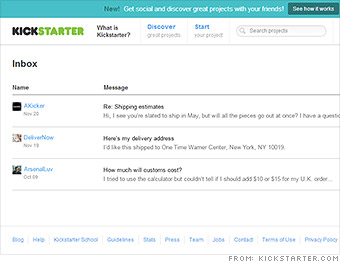

Manufacturing disasters, packing chaos and the whims of Apple are just a few of the unexpected obstacles these Kickstarter creators faced.

Kickstarter's back-end was designed for one-on-one communications with a small circle of supporters.
That's an obstacle for big projects.
"Kickstarter is more like a social network website like Facebook than an e-commerce website like eBay or Amazon," said Daniel Chin, a serial entrepreneur who used Kickstarter to launch his CloudFTP device. "When you are dealing with 2,738 orders, you want the latter."
Chin grew especially frustrated trying to use Kickstarter's mailbox, which lacks "search" or "sort" features. He steered backers with problems to his company's website instead, where his customer-service employees could respond to messages.
Jed Henry, creator of Ukiyo-e Heroes art project, said he had no way to ship prints in the order in which donations were received, partially because "Kickstarter's data management isn't super great."
Another challenge: Kickstarter doesn't collect shipping addresses when people make pledges. Instead, it has project creators send out a survey later to gather the info. If buyers don't respond, there's not much creators can do.
Cartoonist Rich Burlew resorted to what he called "the public shaming portion of the Kickstarter drive" to smoke out his MIA backers. He posted a list of their names on his Kickstarter page, saying that those who didn't get in touch "right now" wouldn't get their goodies.
Kickstarter says it's working on the problem.
"We've made great strides this year on our creator tools, and there's still much to do," says Kickstarter co-founder Yancey Strickler. "The feedback we get from creators is incredibly valuable, and will ultimately lead to a better experience for the entire Kickstarter community." -Stacy Cowley